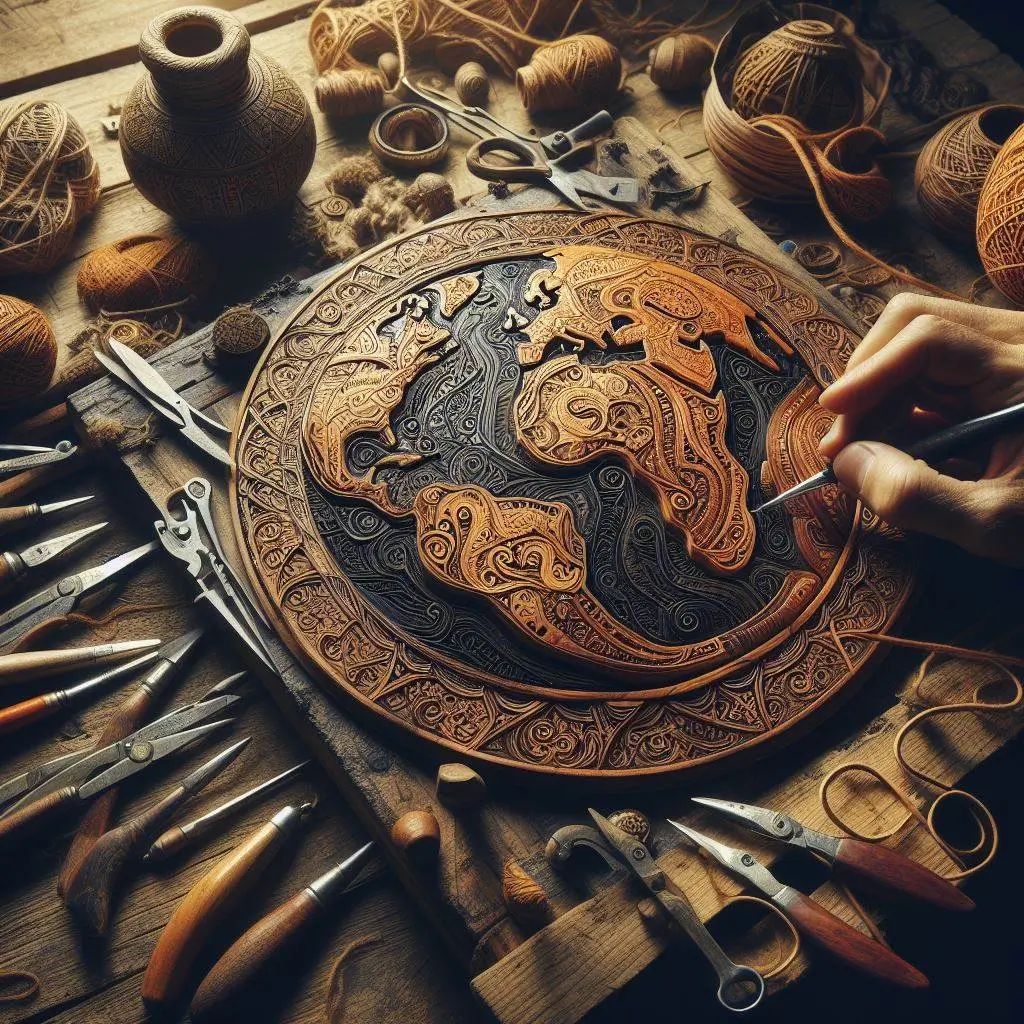
Artisan Trails, Exploring Craftsmanship Worldwide. In the chaos of modern life, there’s a yearning for authenticity, a longing to connect with tradition and heritage. This desire has given rise to a phenomenon known as Artisan Trails – pathways that wind through regions steeped in craftsmanship, offering a glimpse into the soul of artisanal culture. Artisan Trails are not merely routes on a map; they are journeys through time, weaving together the stories of artisans and their crafts. These trails celebrate the mastery of handcrafted goods and the artisans who breathe life into them. More than just a tourist attraction, Artisan Trails represent a revival of age-old traditions and a celebration of human creativity.
Table of Contents
ToggleHistory of Artisan Trails

The roots of Artisan Trails trace back to ancient trade routes where artisans exchanged goods and ideas. Over time, these pathways evolved into modern-day networks, connecting communities and fostering cultural exchange. Today, Artisan Trails serve as conduits of heritage, preserving traditional crafts and passing them down to future generations.
The Role of Artisan Trails in Local Economies
The impact of Artisan Trails extends beyond aesthetics; it’s an economic powerhouse for local communities. By showcasing the talents of local artisans, these trails attract visitors, stimulate spending, and create jobs. Additionally, they help residents feel proud of their identity and contribute to the general well-being of the community.
Exploring Artisan Trails: A Journey Through Craftsmanship
Embarking on an Artisan Trail is like stepping into a living museum, where each stop unveils a new chapter of craftsmanship. From pottery studios to blacksmith workshops, visitors can witness artisans at work, honing their skills passed down through generations. Along the way, they can indulge in handmade treasures, each telling a unique story of its creator.
Continue reading: Artisan Trails: Exploring Craftsmanship Worldwide
Preserving Traditional Crafts
In an era dominated by mass production, Artisan Trails serve as guardians of traditional crafts. By supporting local artisans and promoting their wares, these trails help keep ancient techniques alive. Whether it’s weaving, woodworking, or metalcraft, preserving these heritage skills is essential for maintaining cultural diversity and ensuring a vibrant artisanal landscape.
Artisan Trails as Cultural Heritage

Artisan Trails are not just about products; they’re about people and the rich tapestry of culture they weave. Each artisan brings their unique perspective and expertise, contributing to the cultural mosaic of their region. By celebrating these artisans and their craft, Artisan Trails help safeguard intangible cultural heritage for future generations.
Collaborations and Partnerships
The success of Artisan Trails relies on collaboration – between artisans, communities, and local businesses. By forging partnerships, artisans can expand their reach and tap into new markets. Likewise, businesses benefit from the authenticity and quality associated with artisanal products, enhancing their offerings and attracting discerning consumers.
Continue reading: Artisan Trails: Exploring Craftsmanship Worldwide
Artisan Trail Tourism
Artisan Trails have emerged as magnets for tourists seeking authentic experiences off the beaten path. Unlike conventional tourist attractions, these trails offer immersive encounters with local culture and traditions. Whether it’s savoring artisanal cuisine or attending craft workshops, visitors leave with memories that money can’t buy, fostering a deeper appreciation for the artisans and their craft.
Handmade Treasures: Craft Villages and Artisan Markets
Craft villages and artisan markets are integral components of Artisan Trails, offering visitors a chance to immerse themselves in the local artisanal culture. These vibrant centers display a wide range of handcrafted treasures, from textiles to pottery, providing a look into the world of artisans and fostering a sense of community.
Master Artisans: Stories Behind Craft Traditions
Behind every masterpiece lies a master artisan, whose skill and dedication breathe life into their craft. Artisan Trails offer a platform to showcase these master artisans, sharing their stories and preserving their legacy for future generations. From traditional techniques passed down through generations to innovative approaches pushing the boundaries of creativity, these artisans embody the spirit of craftsmanship.
Challenges and Solutions
While Artisan Trails hold immense potential, they also face challenges, from economic pressures to changing consumer preferences. However, innovative solutions abound, from diversifying product offerings to embracing digital marketing. By staying agile and adaptive, artisans can navigate these challenges and ensure the longevity of their craft.
The Future of Artisan Trails
As we look to the future, the horizon for Artisan Trails appears promising. With growing interest in sustainable living and ethical consumption, artisanal products are poised to take center stage. Moreover, advancements in technology offer new avenues for reaching global audiences while preserving the authenticity of handmade goods.
Continue reading: Artisan Trails: Exploring Craftsmanship Worldwide
Artisan Trails and Sustainability
In an age of environmental consciousness, Artisan Trails champion sustainability. By promoting locally sourced materials and traditional production methods, artisans minimize their carbon footprint and support eco-friendly practices. Furthermore, by fostering a connection between consumers and the makers, Artisan Trails encourage mindful consumption and reduce waste.
Promoting Artisan Trails Online
In the digital age, online visibility is paramount for the success of Artisan Trails. Social media platforms, websites and online marketplaces act as virtual storefronts, enabling artists to present their works to a worldwide audience. Moreover, digital marketing techniques can help elevate the visibility of Artisan Trails, attracting both local and international visitors.
Community Engagement and Education

Artisan Trails thrive on community involvement and education. So, hosting workshops, festivals and educational programmes, artisans can interact with the local community and pass on their skills to the next generation. Likewise, initiatives such as apprentice programs and artisan cooperatives foster collaboration and knowledge exchange, ensuring the continuity of traditional crafts.
Continue reading: Artisan Trails: Exploring Craftsmanship Worldwide
Supporting Artisan Entrepreneurs
Behind every artisanal masterpiece is an entrepreneur with a passion for their craft. Supporting these Artisan is very important, and it requires initiatives like microloans, business incubators, and market access programs. So, by providing resources and mentorship, communities can empower artisans to turn their passion into a sustainable livelihood, enriching both the local economy and cultural landscape.
Exploring Craftsmanship Worldwide
While Artisan Trails offer a glimpse into local craftsmanship, exploring craftsmanship worldwide opens doors to a global tapestry of traditions and techniques. From Japanese ceramics to Italian leatherwork, each culture brings its unique perspective to the world of artisanal crafts. By embracing diversity and learning from different traditions, artisans can enrich their own practices and foster cross-cultural exchange.
Read more:
Literary Trails: Following the Footsteps of Famous Authors
Nomadic Cuisine: Tracing Culinary Roots Through Migration
Conclusion
In a world inundated with mass-produced goods, Artisan Trails offer a sanctuary for those who seek authenticity and soulful craftsmanship. As guardians of tradition and purveyors of creativity, artisans breathe life into their craft, infusing each creation with a piece of their soul. By following the Artisan Trail, visitors embark on a journey of discovery, one that celebrates the beauty of imperfection and the enduring legacy of human creativity.
Unique FAQs
Q1: Are Artisan Trails only for tourists?
A1: While Artisan Trails attract tourists, they also serve as hubs for locals to connect with their cultural heritage and support local artisans.
Q2: How can I find Artisan Trails near me?
A2: You can research online, visit local tourist information centers, or check with community organizations to discover Artisan Trails in your area.
Q3: Do Artisan Trails only feature traditional crafts?
A3: While traditional crafts are a significant component, Artisan Trails also showcase contemporary artisans working in various mediums, from ceramics to textiles.
Q4: Can I purchase artisanal products online?
A4: Many artisans have online storefronts or sell through platforms like Etsy, providing convenient access to their handmade goods beyond the trails.
Q5: How can I support Artisan Trails?
A5: Supporting Artisan Trails can be as simple as attending local craft fairs, purchasing handmade products, or spreading the word about these unique cultural experiences.
